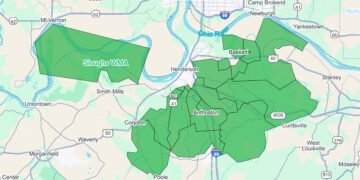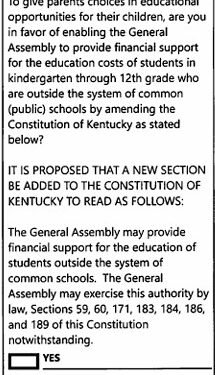(This opinion column first appeared in the October print edition of the Hendersonian.)
On election day this November, Kentuckians will have the opportunity to vote on two proposed amendments to our state Constitution. One of these, Amendment 2, proposes a change to the way state tax dollars are used to fund education, an issue commonly called “School Choice.”
The text of Amendment 2 is simple—it allows legislators to change a part of our state Constitution that was passed in 1891 that prohibits government funding being used to fund any education other than public schools. Most states already have some form of school choice, either through the charter school movement, vouchers, education savings accounts, scholarships or other methods. If Amendment 2 is passed, we could see some combination of these options. None are currently available to Kentucky students.
This may all sound familiar to many of you. It turns out our legislature has already passed these laws in two previous legislative sessions. Each time, opponents to the law have challenged it in court. If the proposed amendment passes, then there won’t be any more challenges based on the wording of our state Constitution.
This issue has become very political. One party (in control of the legislature) is very much in favor of education reform. Another party (with friends in Frankfort) is very much opposed. Unfortunately, this seems to be one more area where lines are drawn between left and right. I honestly believe both sides of our political spectrum care about education and want our kids to succeed. They just seem to have very different ideas about how to accomplish that goal. You can follow the money being spent to sway your vote here.
If the amendment passes, there won’t be any automatic change in the way school funding works. The sun will still rise the day after election day. The proposed law doesn’t spell out HOW things will change; instead, it grants lawmakers the ability to make changes. So, what will lawmakers do if the YES vote wins? Since the bill itself doesn’t say, I did a little research. If this amendment passes, will the legislature authorize the creation of charter schools? Probably—they have tried before. Will the legislature pass a voucher or scholarship program? Probably. Will the legislature continue to fund public education? Yes—public education is still baked into our Constitution and our schools aren’t going anywhere. The best article I could find (that wasn’t transparently paid for by one of the interest groups funding this battle) was from queerkentucky.com. The article put it this way:
If I vote yes on Amendment 2, what does that mean? Honestly, not nearly as much as you might think it means—but also, perhaps even more than you think it means. I’m being so vague because Amendment 2’s impact is incredibly cloudy. Voting yes does not immediately create charter schools or tax credits for folks sending their kids to private schools or publicly funded scholarships for religious schools; nor does it immediately take away funding from public schools as they exist right now.
There are less useful sources of information out there. School choice opponents have prepared an information sheet that suggests private, religious and home schools lack the “oversight, accountability, rules, or transparency of public schools.” I can’t speak for every private or home-schooled child in Kentucky—then again, neither can opponents of school choice—but the implication here is that only public schools have an appropriate degree of oversight, accountability, rules and transparency. I am not sure anyone believes that. One of, if not the main reason for the school choice movement, was dissatisfaction with public school options. Fortunately, in Henderson we have good public schools. Many students throughout the state are not so fortunate. Ultimately as parents, we have a responsibility to our children to provide them with the kind of education they will need to become successful. For some people, that education simply cannot be found in their child’s assigned public school district.
Opponents, in a KEA article on its website, claim that “if Amendment 2 passes, the legislature will be able to set education funding policy for Kentucky without having to answer to the people or to the courts.” Huh? The legislature doesn’t have to answer to the people? Does the person who wrote this know that it’s an election year? Doesn’t have to answer to the courts? We’re only dealing with this again, for the third time, because our courts have been involved from the beginning. This kind of dishonest language doesn’t help anyone.
Charter Schools
What is a charter school, anyway? Charter schools are “publicly-funded schools that operate independently from their local district.” Opponents to school choice call them “unaccountable private schools.” There is a well-known one right across the river in downtown Evansville, called Signature School. It is currently ranked the second-best high school in the U.S. Doubtless there are good charter schools, and there are bad charter schools, just like there are good public schools and bad public schools.
Are they accountable? Well, in 2019 the National Education Association issued a national Charter School Report Card. Their grading scale ranges from “Adequate” to “Abysmal”, which makes the reader wonder if the NEA might be slightly biased. Not surprisingly, most states are “Very Poor” or “Abysmal”. Very surprisingly, Kentucky scored “Mediocre.” Not bad for a state that had exactly zero charter schools in 2019.
The grade was based on the original school choice laws passed by our lawmakers—the ones that were overturned in court. We would have done worse, but it turns out that Kentucky got a perfect score in the “Accountability” section. When the NEA, which really does not like charter schools, says your state laws hold charter schools accountable, then they probably do.
Many existing private schools in Kentucky—including local schools like Holy Name and Owensboro Catholic High School—are also held accountable through accreditation in the Kentucky Non-Public School Commission.
Vouchers and Scholarships
Aside from charter schools, the other aspect of school choice that has everyone on both sides fired up is, shockingly… the money. To be very clear, it is your money—schools are funded from a combination of taxes, state budget allocations and grants. Ultimately, all that money comes from us. A portion of the public funding is called “SEEK” money. It represents a fixed amount per student that is paid to the school where that student is enrolled. Next year, the per-student amount of SEEK funds will be $4,326. Private and religious schools don’t get SEEK funds. If a student leaves East Heights or HCHS to attend a charter school (you will have to use your imagination since we don’t have any), then that school would no longer receive the SEEK money allocated to that student. To put it another way, our education funding model doesn’t fund schools; it funds students.
Fortunately, this money is only a portion of what is spent on each student. According to the Kentucky Department of Education’s School Report Card website, our school district spends $16,010 on each student. In other words, per pupil funding amounts to about one quarter of per pupil spending in our local public school system. Although we can’t predict how a voucher or scholarship program would affect per pupil spending, there is some pretty good research—from edchoiceky.com—that suggests scholarship tax credits would actually help the state budget.
Are these programs going to implode our public school system? Are children moving from public schools to private or charter schools going to receive a subpar education? The Kentucky Education Association certainly thinks so. They allege hundreds of millions of dollars would be pulled out of the public school system, jeopardizing almost 2,000 teachers’ jobs. A bold prediction, since they have precisely zero data points to draw this conclusion from, but we can look to results in other states. It turns out there are lots of studies showing that school choice programs produce better educational outcomes (pp.21-24) and save taxpayer money. As with most issues, there are a lot of smart people on both sides waving a lot of numbers and claiming their side is right and the other side is wrong.
Because these programs don’t currently exist here, we have no track record to judge their effectiveness. All we can do is look to other states and try to learn from their experiences. Almost every state in the country has some form of school choice on their books, including every state surrounding Kentucky. Some states limit vouchers and scholarships to students currently enrolled in public schools, or to particular groups such as low income or special needs students. Other states allow universal access to the program, meaning that every tax-paying parent has the freedom to direct how their money is spent.
We will have a lot of choices to make in November. Some of them don’t really matter (looking at you, Amendment 1). Some of them do. We can vote “Yes” on Amendment 2, and revisit a law passed over a century ago, when Benjamin Harrison was in the White House (remember him?) and most Kentuckians didn’t have electricity or running water. Or we can vote “No,” cross our fingers and hope for the best while the rest of the country forges ahead. Times change.
Chris Stearns is a local attorney. He was born and raised in Henderson and has four children.

























